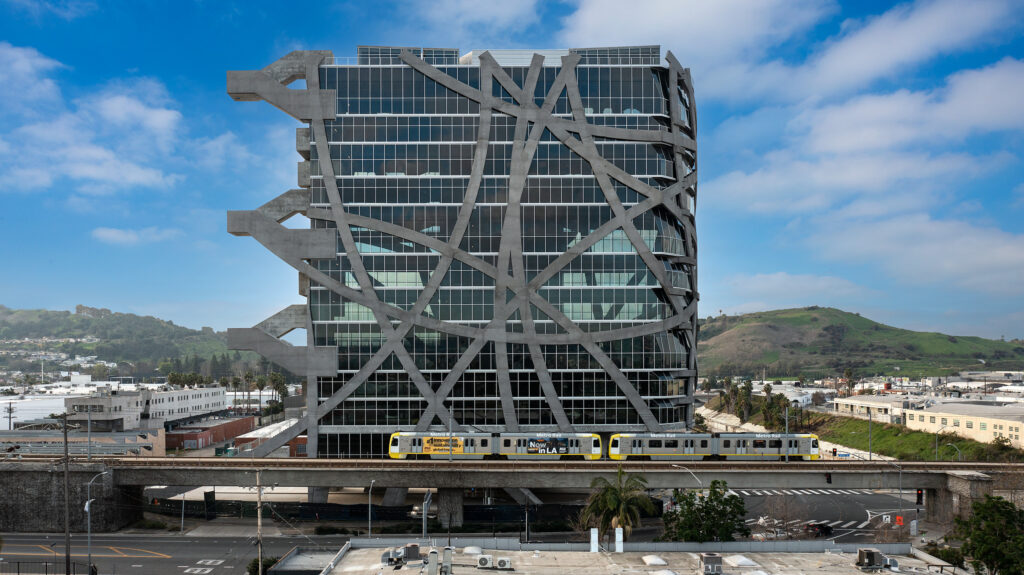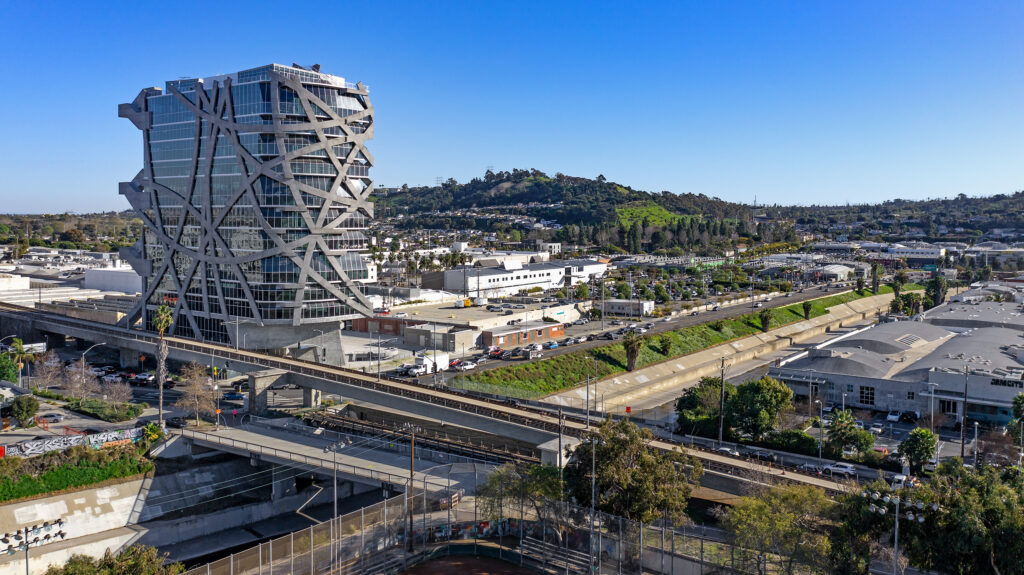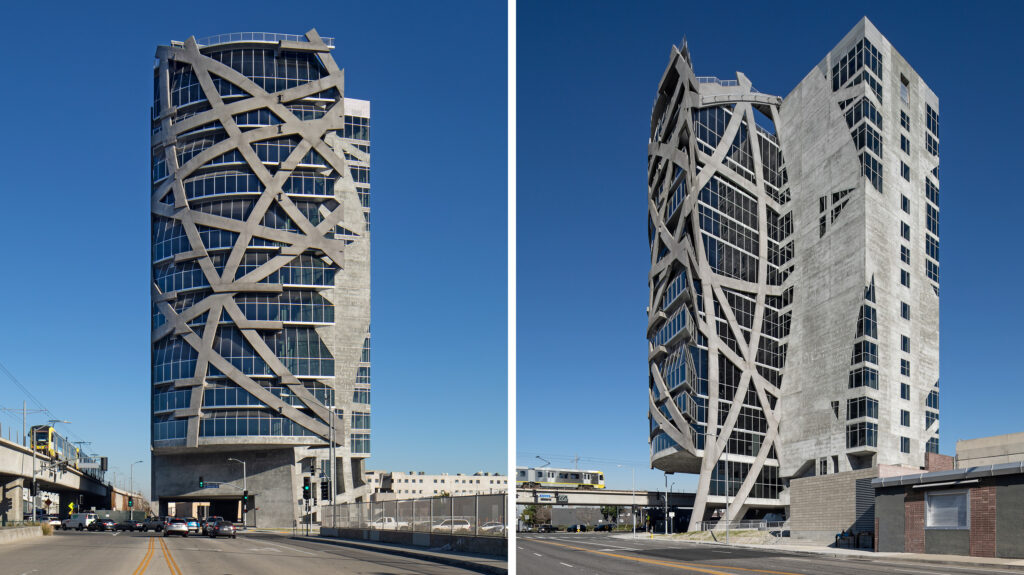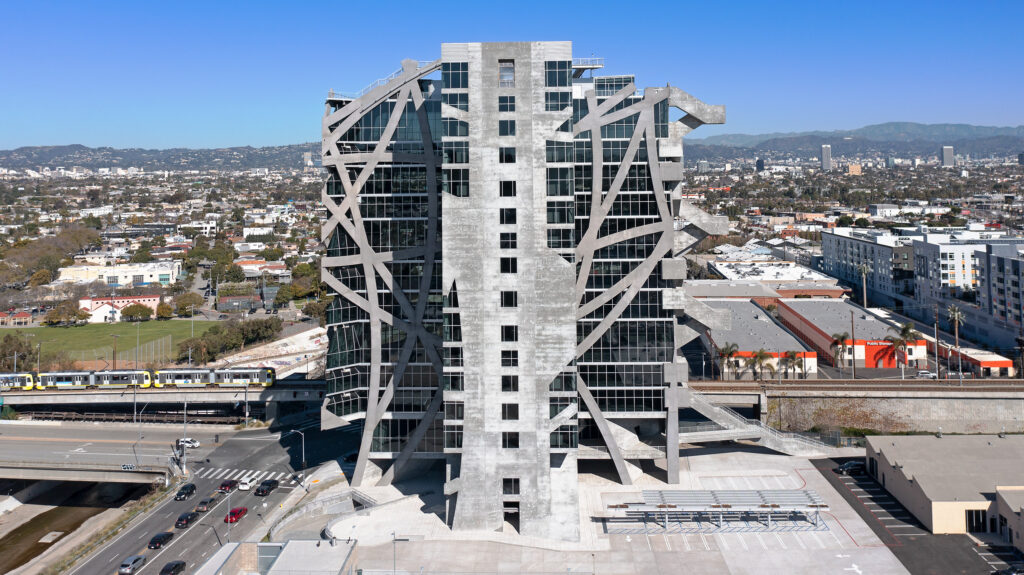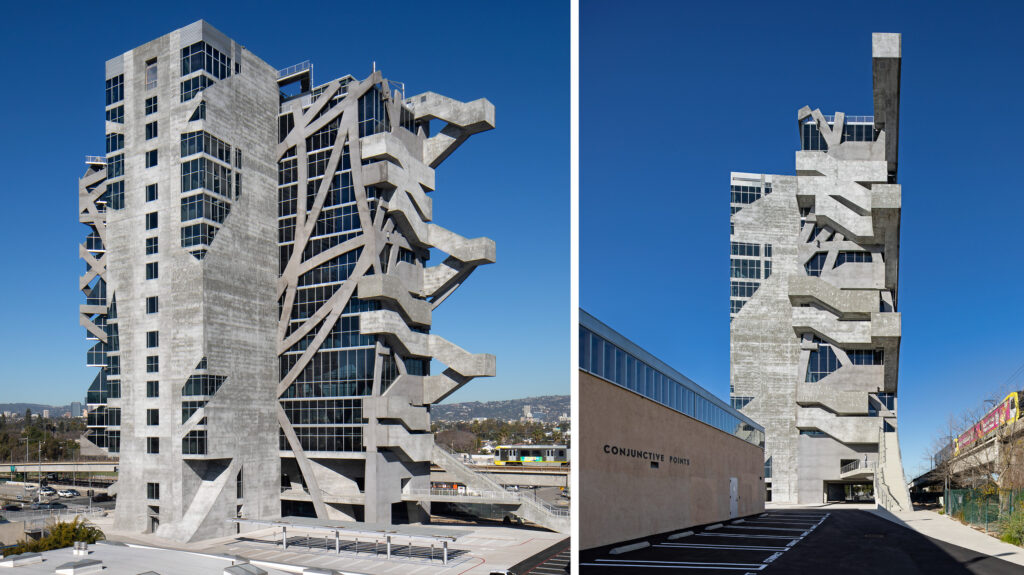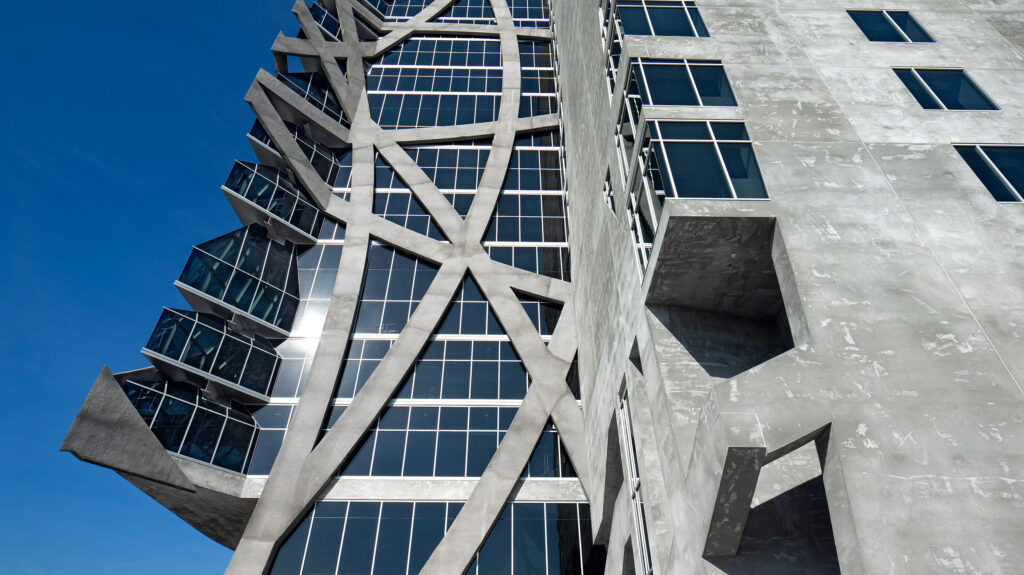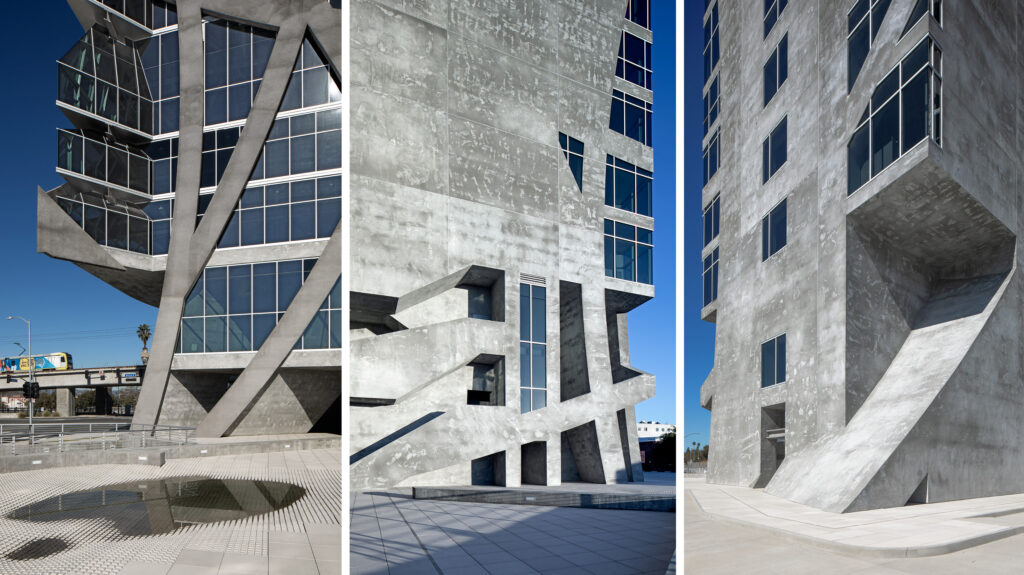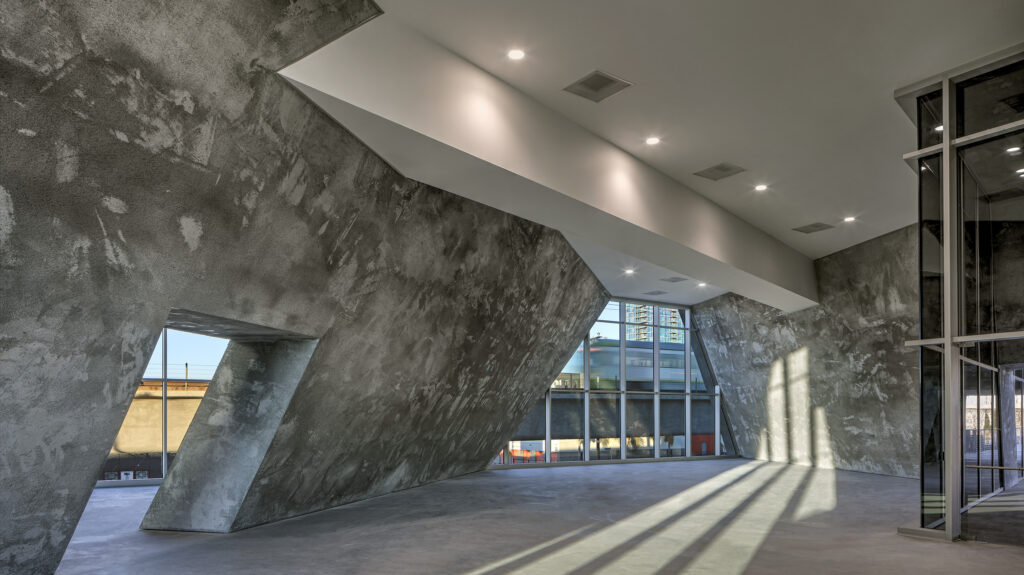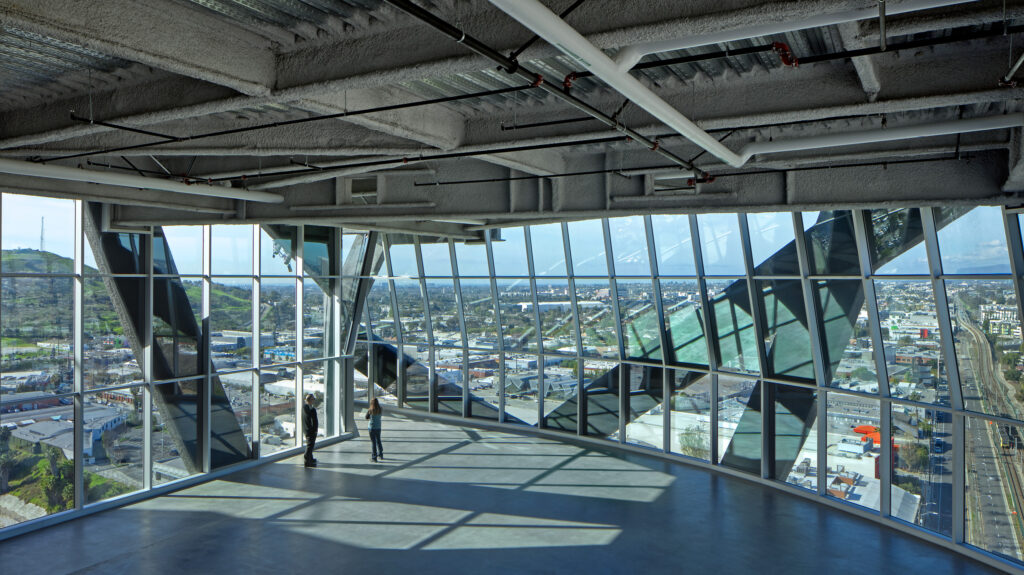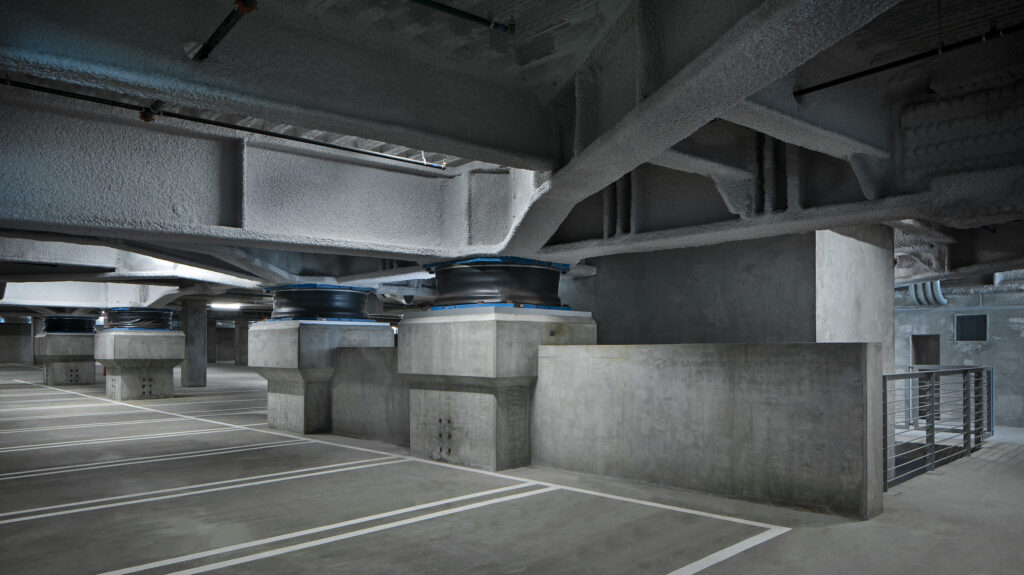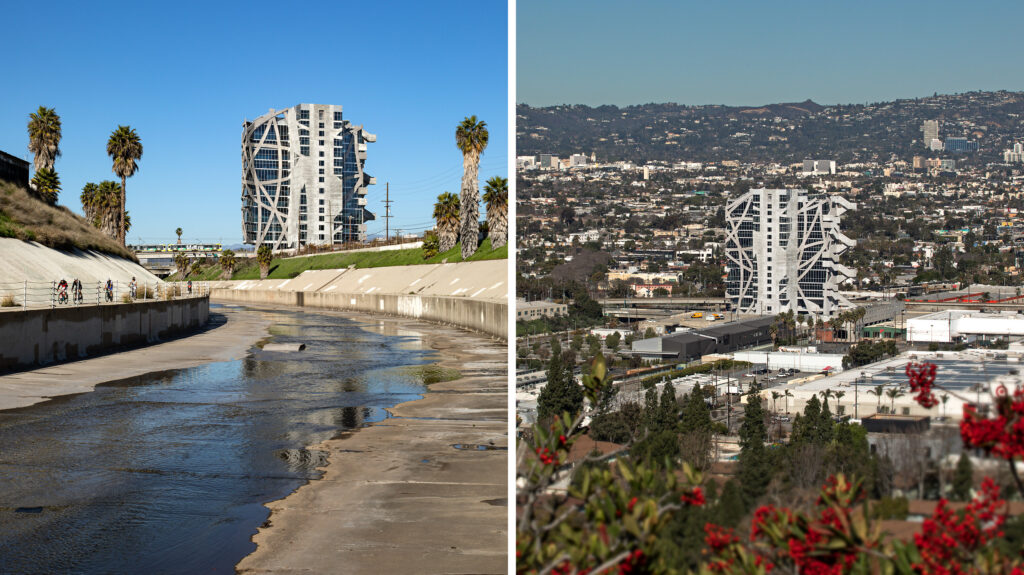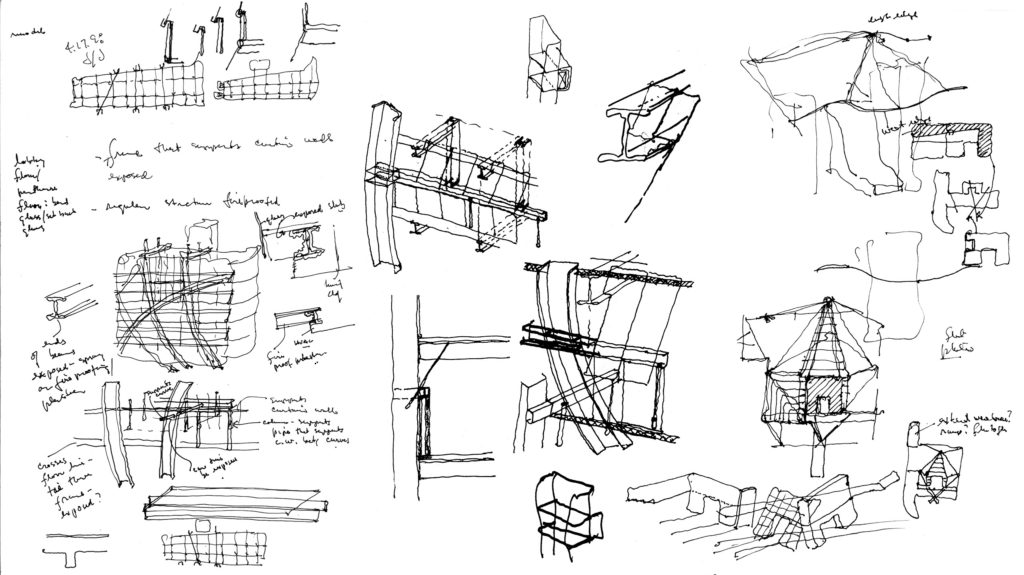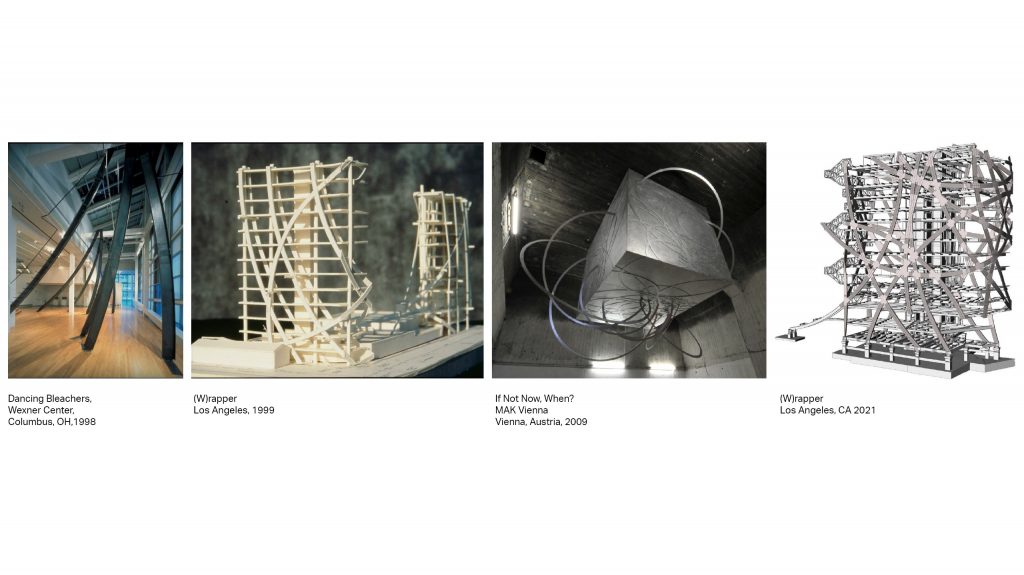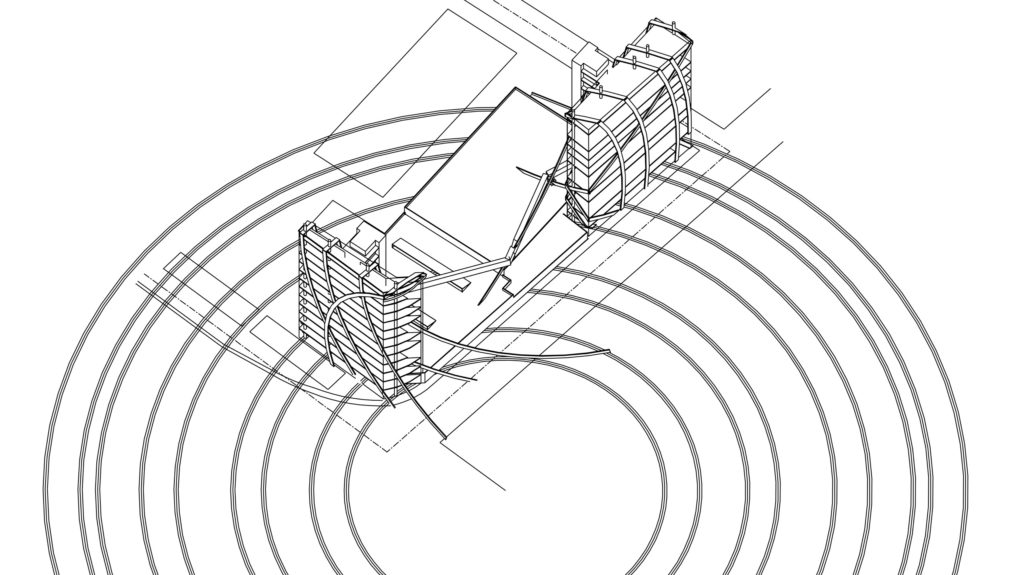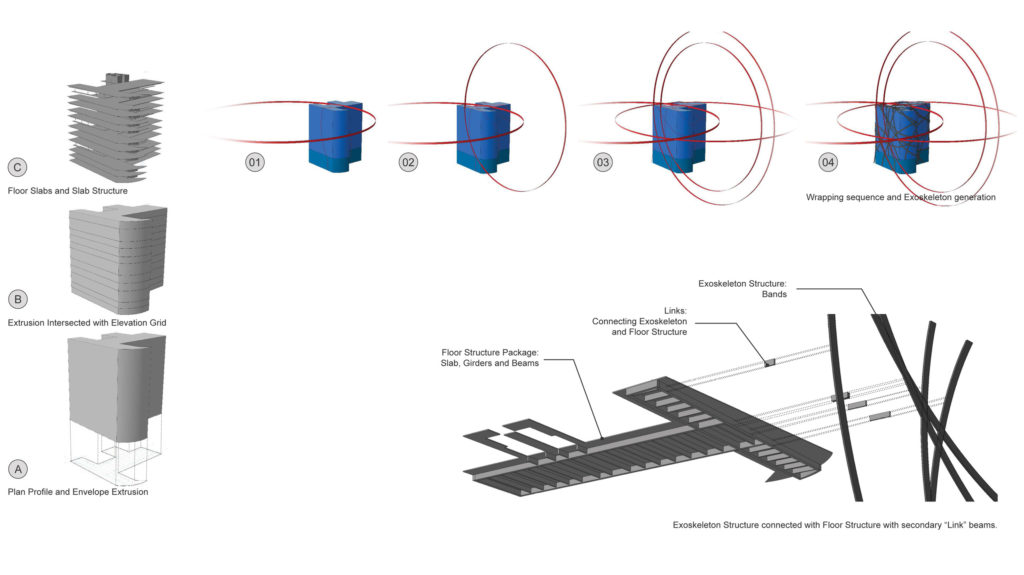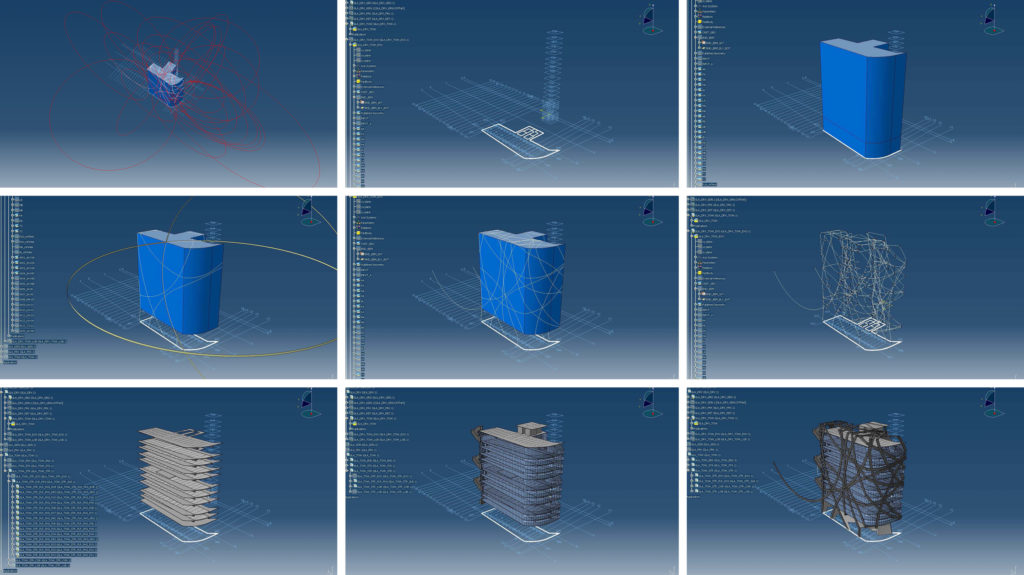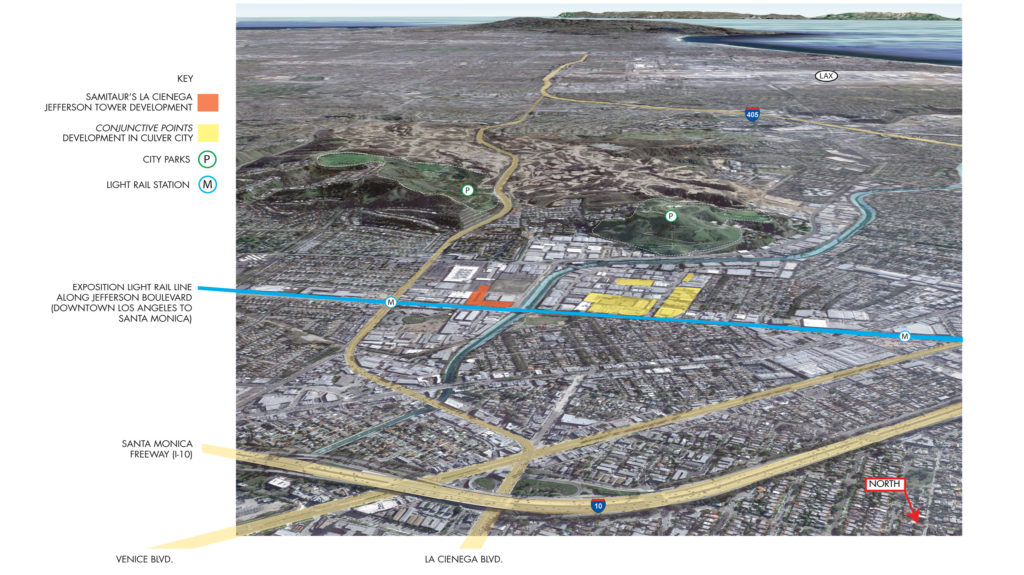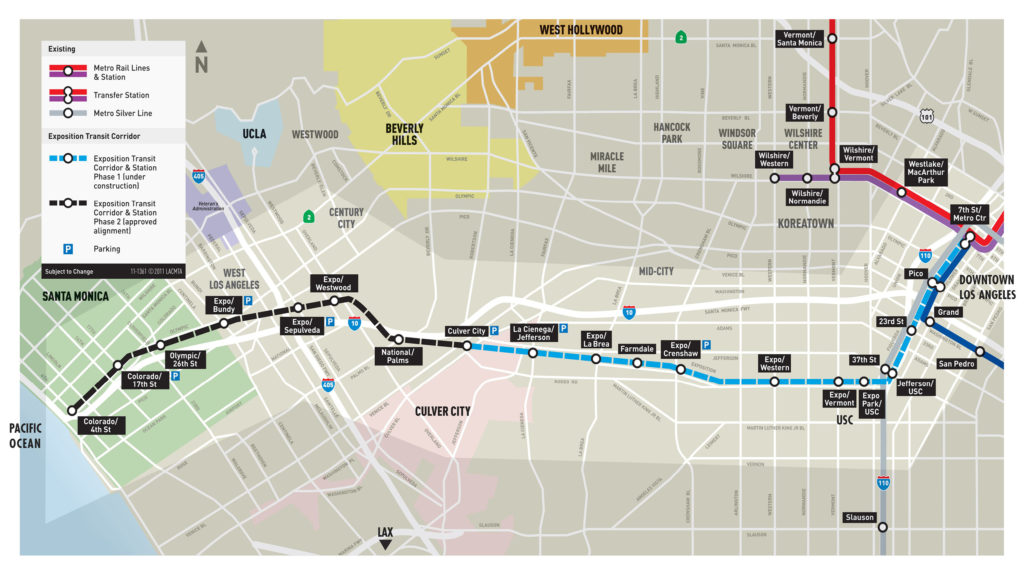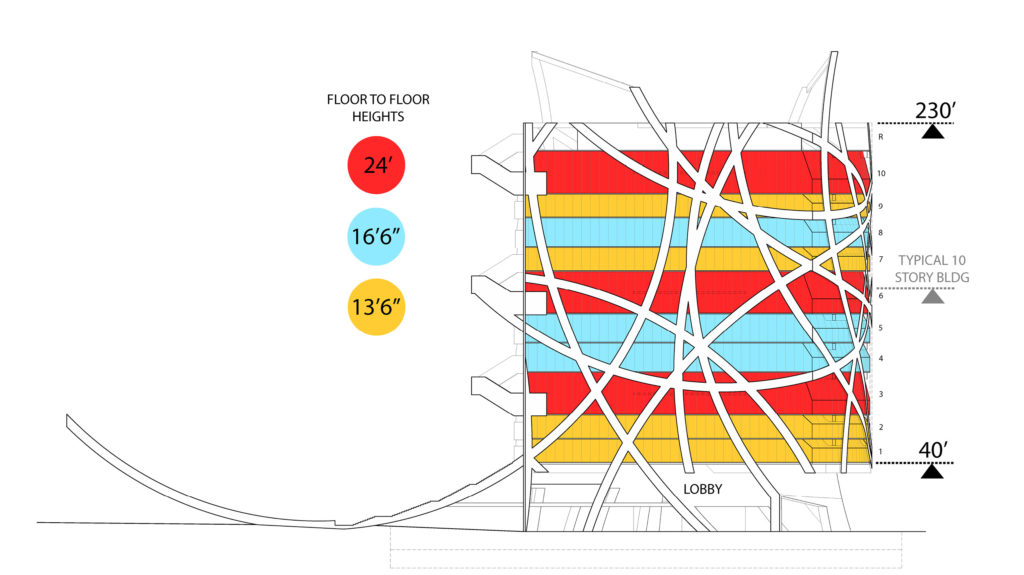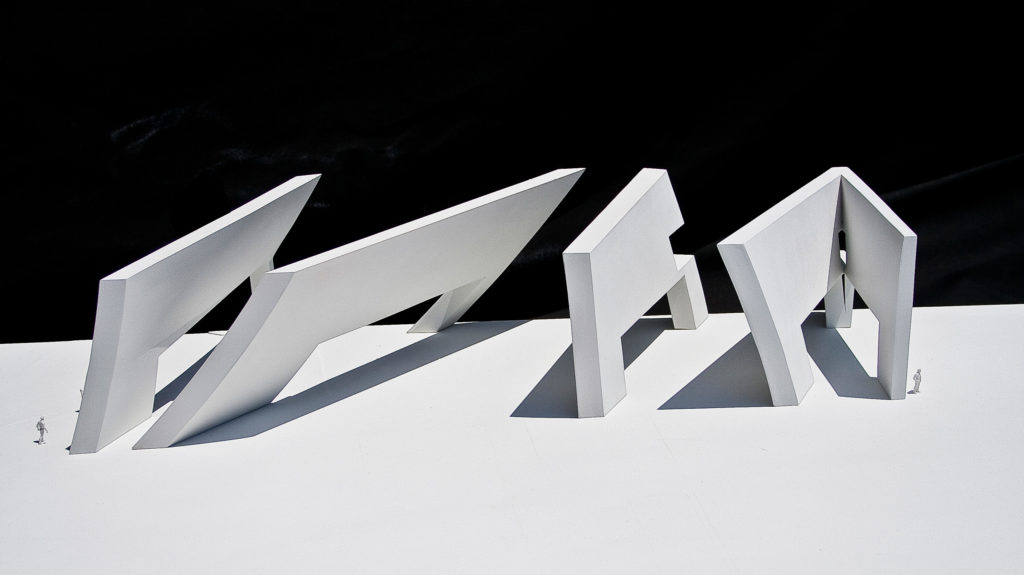Location
Los Angeles, California
Program
Office
Size
183,000 gross square feet, 235' tall.
Dates
1997-2023
Construction Systems
Built-up steel plate band exoskeleton with exposed cementitious fire proofing, wide flange girder floor framing with exposed metal deck at perimeter, steel plate shear walls (SPSW) at core, triple pendulum base isolated structure, aluminum window wall glazing, cement plaster hyperbolic support walls and stair enclosures, cast in place concrete subterranean garage.
Key Staff
Eric Owen Moss, Dolan Daggett, Vanessa Jauregui, Maxime Lefebvre, Hugo Ventura, Raul Garcia, Eric McNevin, Juan Villarreal, Scott Nakao, Diana Rodriguez, Emmanuel Osorno, Renata Galan, Brennen Huller, Sean Briski, Nicholas Barger, Zarmine Nigohos, Tanveer Sami, Richard Yoo, Christine Lawson, Francisco Delgado
Key Consultants
Structural Engineer: Arup, Los Angeles
Geotechnical Engineer: WSP
MEP Engineer (Design Development): Arup, Los Angeles
Civil Engineer: Arup, Los Angeles
Smoke Control: Arup, Los Angeles
Landscape Architect: Land Images
Commissioning: Green Dinosaur
Shoring Engineer: Earth Support Systems, Inc
Surveyor: J.O. Nelson & Associates
Technology: Vantage
Acoustics: Arup, Los Angeles and Antonio Acoustics
Traffic: KOA Corporation
Hardware: Jon Wiseman
Awards
Fast Company Innovation by Design Award, 2023
ASCE - Metro Los Angeles Branch, Outstanding Structural Engineering Project, 2023
NCSEA Structural Engineering Excellence Award, 2023
Engineering News Record Best Office/Retail/Mixed Use Project, 2023
IMPACT Project of the Year, 2023
Architect Magazine Research and Development Award, 2015
AIA/LA NEXT LA Merit Award, 2010
Photographer
Tom Bonner Photography
Eric Owen Moss Architects recently completed construction of (W)rapper, a new 235-feet tall office building and the latest EOMA contribution to an on-going 35-year revitalization plan for a former industrial and manufacturing zone in Central Los Angeles and Culver City, California.
The client is Samitaur Constructs; partners are Frederick and Laurie Samitaur Smith.
Located along the Expo Line light rail connecting West Los Angeles with Downtown, the project conforms to the City’s long term planning goal to increase density along mass transit routes, in this case, in a neighborhood that historically limited heights to 45 feet. At 235 feet in height (W)rapper implements a new scale, density and multi-purposes for the area.
(W)rapper’s structural concept originated in 1998 and was first presented in an exhibit at the Wexner Center in Columbus, Ohio. Unlike conventional high-rise structural systems based on columns organized along modular grid lines, (W)rapper is supported by a network of curvilinear bands originating from a number of geometric center points. Each curving band is wrapped around the largely rectilinear building envelope, and folded around each vertical and horizontal corner of the building until it reaches the ground.
The bands are supported on a base isolated foundation which separates the tower structure above from the isolator foundations below, allowing the building to respond and move safely and securely in any seismic event.
The base-isolated structure adds to the sustainable building conception, providing a structure five times more seismically resilient than a typical American high-rise. This tower will survive a major earthquake and return its occupants to the office the following day. Other high-rise building facing similar seismic challenges will sustain significant damage and likely require demolition or substantial reconstruction before reoccupying.
The ‘reoccupy next day’ structural lifecycle of (W)rapper, the key measure of its sustainability, will reduce the carbon footprint of the project substantially over its useable lifetime. In comparison with more conventional structural concepts, (W)rapper offers both the city and its tenants the highest possible seismic safety rating in the United States.
(W)rapper is the only high-rise commercial office building in the USA that utilizes such a base isolated structure.
The steel bands are coated with cementitious fireproofing, and the building core is clad in a two-coat cement plaster finish. There is no concrete in the structural or fireproofing concept of the (W)rapper.
The bands are positioned on the building perimeter creating an open, column-free floor plan that provides the maximum opportunity for interior planning options. The elevator and utility core of the building is offset to the south, freeing the office interiors, and providing the maximum floor plan flexibility.
The seventeen office floors are distributed as three different floor-to-floor height options – 13’-6”, 16’-6”, and 24’-0” – with a mezzanine hung from the ceiling above on the 24’-0” floor. Again, the widest range of use and spatial experience opportunities are available to tenants.
Minimal perimeter band impediments offer wide, uninterrupted vistas of the entire Los Angeles basin from every floor.
(W)rapper advances a continuing history of sustainable development by Eric Owen Moss Architects in the Culver City and Los Angeles areas. Earlier projects reused the former industrial buildings, interspersed with remodeling, and an occasional building addition. The (W)rapper site combines both existing and remodeled buildings with new construction, adding density and offering new office plan options.
The project promotes the use of public transportation and a concomitant reduction of fossil fuel usage—with reduced availability of private and public auto parking and a direct pedestrian link from train to building lobby. A number of active and passive environmental strategies produce a high-performance building envelope which is equivalent to an elevated LEED Silver sustainability rating.
The project is the first of three new towers designed by EOMA for the area. The other two towers have been approved by the City of Los Angeles, and a pedestrian bridge connecting Culver City to the west with Los Angeles that will unify two local and burgeoning digital communities is currently being discussed with local government agencies.
